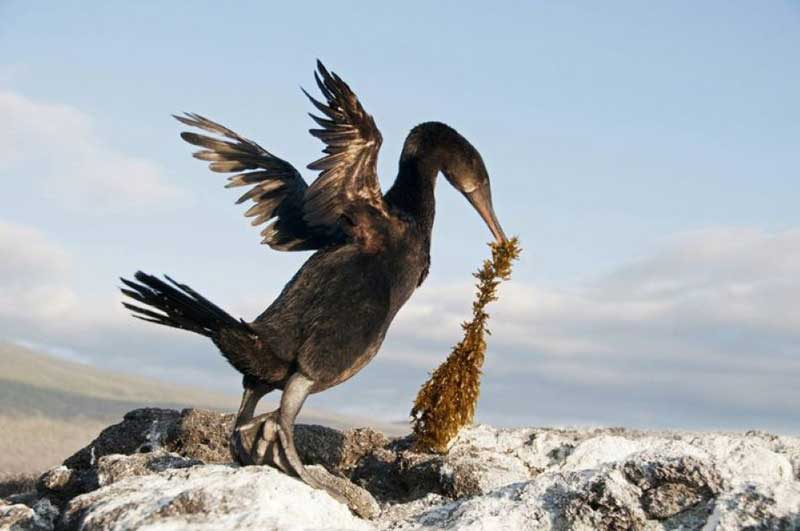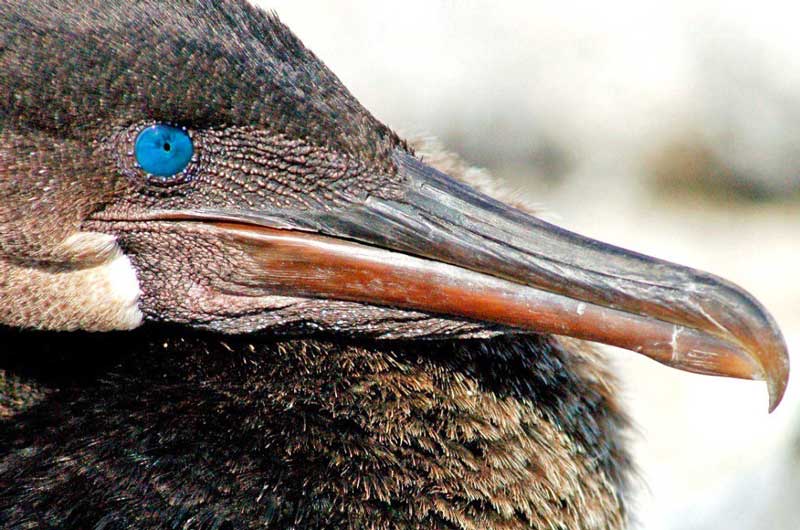
As the name suggests, the flightless cormorants, endemic to the Galapagos Island, an archipelago of volcanic islands in the Pacific Ocean, part of the Republic of Ecuador, cannot fly and forages on the lava shoreline and beaches of Isabela and Fernandina. Their stunted wings are one third the size of the wingspan they would require to fly and the keel on the breastbone of the birds, where the large muscles needed for flight are formed, is also significantly reduced. But although they do not have functional wings, they had very few land predators, and they use their wings for balance when they jump from rock to rock along the coast.
With a large body and tiny wings, the Galapagos cormorants resemble overgrown baby birds and although they cannot fly, they can swim to forage in shallow coastal waters, including bays and straits. It is considered that they diverged from their flying relatives approximately 2 million years ago, as they had very few land predators to fly away and only needed to dive for food.

With its length measuring 35 to 39 inches and weighing 3 to 5 kg, the Galapagos flightless cormorant is the largest extant member of its family, equipped with four webbed toes and sturdy legs that propel it through the water as it seeks its prey of fish and other little marine creatures. The adults are black on top and dark brown underneath with long beaks hooked at the tip and bright turquoise eyes. Although males and females are similar in appearance, males are larger and heavier, while juveniles generally resemble adults, are glossy black in colour with dark eyes. Their body feathers are much thicker, softer and denser than those of other cormorants.
But their feathers are not waterproof as they produce very little oil from their oil gland and after each dive, they need to sit on a rock with their wings spread out to dry them in the sun. During that time, although they seem to be trying to be majestic, they look pretty funny with their dinky little wings held out and glowing in the sunlight. However, the air trapped in their dense plumage keeps them warm and afloat.

Flightless cormorants are extremely sedentary in nature, and mostly they prefer to stay on local stretches of the rocky coastline several hundred metres long and forages mostly in the shallow coastal waters. Usually, they sit calmly on the surface of the water body, with only their necks visible from a distance. But they tuck in their wings for diving deep to the ocean floor and kick with their powerful hind legs, using their flexible necks to pierce and pick octopus, eel, squid and rockfish from inside small refuges in the reefs and rocks.

The breeding period of the flightless cormorants is between May and October, when the temperature of the water surface is cold, resulting in an abundance of marine food, and the risk of heat stress on the hatchlings is less. The courtship begins in the sea, when the male and female swim around each other intertwining their necks whilst twirling in a tight circle.
After that preliminaries, the pair move onto land and items like seaweed, flotsam and jetsam are mainly brought by the male to be woven into a nest a few metres from the high watermark. During that time, even breeding colonies are formed, consisting of up to about 12 pairs. Usually, the female lays three whitish eggs per clutch, out of which only one chick survives. Both the parents share equally in incubation and when the eggs have hatched, both continue to share the responsibilities of protecting and feeding the offspring. As the chicks approach independence in between two to three months, the female deserts the offspring, provided food supplies are plentiful at that time, leaving the male to carry out further parenting, while she starts a new breeding cycle with a new mate, which can happen up to three times in one season.

The flightless cormorant is considered one of the rarest birds in the world. Despite its longevity of around 13 years, a survey carried out in 2004 indicated that the species has a population of only about 1,500 individuals. However, recently the population has stabilised due to conservation actions. The Galapagos archipelago was designated as a World Heritage Site in 1978 and the recent estimate of about 1679 individuals in 2011 are found within the Galapagos National Park and Marine Reserve. Apart from the continuation of annual monitoring programs, the future conservation proposals include restrictions on human visitation, the prevention of fishing with nets in the bird's foraging range and creating a plastic pollution free Galapagos.